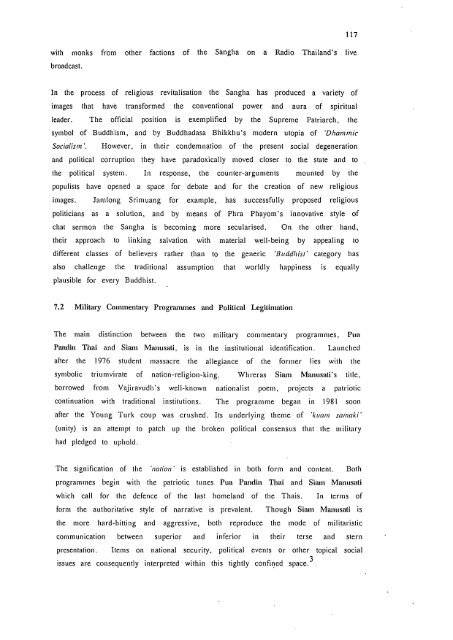iieiiei1eWrkers - Leicester Research Archive - University of Leicester
iieiiei1eWrkers - Leicester Research Archive - University of Leicester
iieiiei1eWrkers - Leicester Research Archive - University of Leicester
You also want an ePaper? Increase the reach of your titles
YUMPU automatically turns print PDFs into web optimized ePapers that Google loves.
with monks from other factions <strong>of</strong> the Sangha on a Radio Thailand's live<br />
broadcast.<br />
In the process <strong>of</strong> religious revitalisation the Sangha has produced a variety <strong>of</strong><br />
images that have transformed the conventional power and aura <strong>of</strong> spiritual<br />
leader. The <strong>of</strong>ficial position is exemplified by the Supreme Patriarch, the<br />
symbol <strong>of</strong> Buddhism, and by Buddhadasa Bhikkhu's modern utopia <strong>of</strong> 'Dhan,mic<br />
Socialism'. However, in their condemnation <strong>of</strong> the present social degeneration<br />
and political corruption they have paradoxically moved closer to the state and to<br />
the political system. In response, the counter-arguments mounted by the<br />
populists have opened a space for debate and for the creation <strong>of</strong> new religious<br />
images. Jamlong Srimuang for example, has successfully proposed religious<br />
politicians as a solution, and by means <strong>of</strong> Phra Phayom's innovative style <strong>of</strong><br />
chat sermon the Sangha is becoming more secularised. On the other hand,<br />
their approach to linking salvation with material well-being by appealing to<br />
different classes <strong>of</strong> believers rather than to the generic 'Buddhist' category has<br />
also challenge the traditional assumption that worldly happiness is equally<br />
plausible for every Buddhist.<br />
7.2 Military Commentary Programmes and Political Legitimation<br />
The main distinction between the two military commentary programmes, Pun<br />
Pandin Thai and Siam Manusati, is in the institutional identification. Launched<br />
after the 1976 student massacre the allegiance <strong>of</strong> the former lies with the<br />
symbolic triumvirate <strong>of</strong> nation-religion-king. Vihreras Siam Manusati' s title,<br />
borrowed from Vajiravudh's well-known nationalist poem, projects a patriotic<br />
continuation with traditional institutions. The programme began in 1981 soon<br />
after the Young Turk coup was crushed. Its underlying theme <strong>of</strong> 'kuam samaki'<br />
(unity) is an attempt to patch up the broken political consensus that the military<br />
had pledged to uphold.<br />
The signification <strong>of</strong> the 'nation ' is established in both form and content. Both<br />
programmes begin with the patriotic tunes Pua Pandin Thai and Siam Manusati<br />
which call for the defence <strong>of</strong> the last homeland <strong>of</strong> the Thais. In terms <strong>of</strong><br />
form the authoritative style <strong>of</strong> narrative is prevalent. Though Siam Manusati is<br />
the more hard-hitting and aggressive, both reproduce the mode <strong>of</strong> militaristic<br />
communication between superior and inferior in their terse and stern<br />
presentation. Items on national security, political events or other topical social<br />
issues are consequently interpreted within this tightly confined space.3<br />
117














